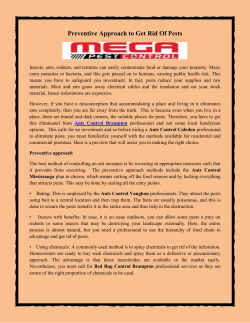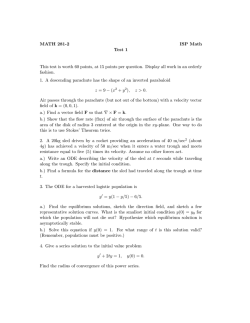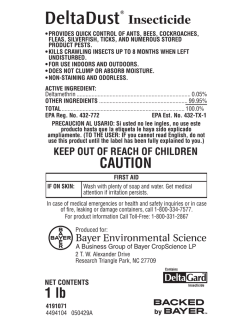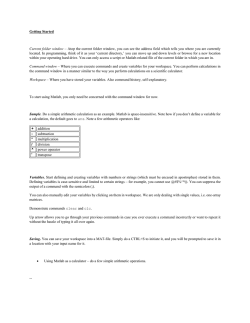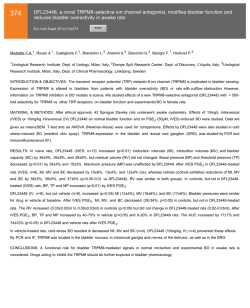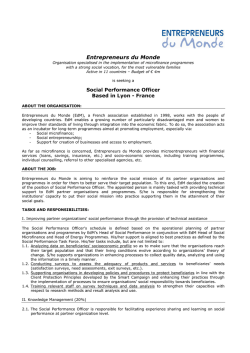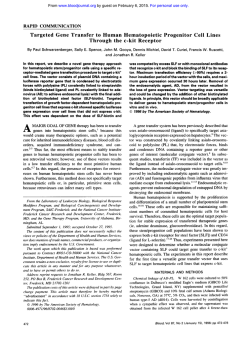
The pests caused diseases and strategy of their control
Direct Research Journal of Agriculture and Food Science ISSN 2354-4147 www.directrearchp ublisher.o rg The pests caused diseases and strategy of their control Direct Research Journal of Agriculture and Food Science (DRJAFS) Vol.3 (2), pp. 48-50, February 2015 Available online at directresearchpublisher.org/drjafs ISSN 2354-4147 ©2015 Direct Research Journals Publisher Review El-Aleem Saad Soliman Desoky Plant Protection Department (Zoology), Faculty of Agriculture, Sohag University, Egypt. ABSTRACT This paper consider the many pests that transmit diseases to humans or animals, whether pests, insects or animals such as flies, mites,… etc. and study strategy for control these pests with the recommendations of modern trends in the controlling against these pests, according to the World Health Organization. *Corresponding Author E-mail: [email protected] Accepted 4 January, 2015 Key Words: Flies, modern trends, transmit diseases, World Health Organization. INTRODUCTION Every year, hundreds of millions of cases of insect-, snailand rodent-borne diseases occur, representing a major threat to global public health. Vector-borne diseases account for around 17% of the estimated global burden of infectious diseases. Operational, financial and managerial problems, together with environmental change, pesticide resistance and increasing population mobility have contributed to increases in the prevalence of many of these diseases in recent decades. Diseases that are usually transmitted via vectors or intermediate hosts include dengue, filariasis, Japaneseence phalitis, leishmaniasis, malaria, onchocerciasis, sarcoptes, schistosomiasis and trypanosomiasis. They should be applied in accordance with the principles of integrated vector management an evidencebased decision-making process adapted to local settings, which rationalizes the use of vector control methods and resources and emphasizes the involvement of communities. This is the sixth edition of a guide to the use of chemical methods for control of vectors and pests of public health importance. It provides staff involved in operational vector control programmes with practical information on the safe and effective use of pesticides as well as information on the use of chemicals for individual and household protection from insect and rodent pests. In many countries with endemic infestation with pests, vector control strategies have evolved from large, centrally organized vertical programmes to decentralized programmes integrated into general health services. The dwindling arsenal of safe, cost-effective pesticides for public health use, increasing concern about the environmental and safety implications of the widespread use of chemicals and the need to use more and more limited health sector funds to the maximum benefit has resulted in greater emphasis on the judicious use of pesticides. Thus, non-chemical measures are the first option, and use of chemical interventions is considered only when necessary. The selection and use of different chemical and nonchemical methods for vector and pest control should be based on their efficacy, sustainability and costeffectiveness. World Health Organization (2006). Direct Res. J. Agric. Food. Sci. 49 THE PESTS CAUSED DISEASES In addition, it has recently been confirmed that domestic flies play a significant role in the mechanical transmission of diarrhea diseases and trachoma. Although these two diseases are also transmitted by other routes, they are such important causes of child death and blindness that domestic flies should be considered of major significance as disease vectors. Vector control is an important component of many vector-borne disease control programmes. Its implementation includes targeted, sitespecific use of the available methods, predicated on technical and operational feasibility, resources and infrastructure. Bathing by water can remove a significant number of Sarcoptesscabiei mites from the affected people and animal’s body; however, inappropriate bathing may affect the skins of the affected people and animals. Washing the bodies of people and animals infested with Sarcoptesscabiei mites may also cause skin dryness and scratches and may harm them because dry skin is more proven to severe itching and irritation. In such conditions people and animals affected with Sarcoptesscabiei may lead to other health problems such as dermatitis, pyoderma and sometimes eczema and urticaria. Treatment of Sarcoptesscabiei generally entails the application of topical creams for classical scabies; however, oral application of ivermectin is good to treat crusted scabies (Mounsey et al., 2008). Domestic rodents are closely associated with man and his environment. Rodents can play both direct or indirect roles in the transmission of human diseases ( Zahedi et al., 1996) and (Abo-Elmaged and Desoky 2013)The role of house rats in the transmission of diseases of public health importance in urban and semi-urban environment should not be underestimated. They are reservoir hosts for a number of parasites, plague and other pathogens. Although house rats live in gardens and rubbish dumps, they are rarely far from man; 6% of the rats trapped in the city during the study harboured the cat flea, Ctenocephulidesfelis. The public should be cautious of these potentially dangerous creatures and efforts must be made to eliminate them. The aim of the study was to elucidate the ectoparasite fauna of urban house rats and to compare that fauna to those of rats caught from the surrounding semi-urban areas. The emphasis of the study was on flea infestation of urban rats and their role in transmission of diseases of public health importance. THE PRINCIPLES MANAGEMENT OF INTEGRATED PESTS The cost-effectiveness of all the vector control strategies used in a wide range of settings, and this subject is addressed elsewhere. Despite the growing contribution of alternative measures, chemical control will continue to play a vital role in vector-borne disease control, particularly when rapid, effective control is essential, such as during disease epidemics. Community-based vectorborne disease control has received greater emphasis in recent years. Notably, the demonstration that insecticidetreated mosquito nets can reduce mortality and morbidity due to malaria led to the promotion of net use in many malarial areas. Greater attention has also been paid to personal and household protection from insect vectors and intermediate rodent hosts and to community participation in eliminating vector breeding sites. The provision of information on simple, effective, acceptable methods for reducing the sources of vector sand for personal protection at a reasonable cost is an important part of vector control programmes. WHO RECOMMENDATIONS AND RECENT TRENDS OF PESTS CONTROL Four classes of chemical insecticides—the organochlorines, the organophosphates, the carbamates and the pyrethroids—are still the mainstay of vector control programmes. Use of pyrethroid insecticides has, however, increased, and that of the organochlorines and some of the more toxic organophosphate compounds has decreased in recent years. The continued use of DDT for disease vector control is conditionally approved under the Stockholm Convention on Persistent Organic Pollutants in accordance with WHO recommendations and guidelines, and when locally safe, effective and affordable alternatives are not available. Use of the bacterial insecticides, Bacillus thuringiensisisraelensis (serotype H-14) and B. sphaericushas increased in response to the demand for safe, pest-specific compounds. Although these materials are considered to be biopesticides, they are included in this manual with chemical insecticides as larvicides for control of mosquitoes and black flies. Insect growth regulators have also become more widely used in recent years. These compounds can be divided into juvenile hormone analogues (juvenoids), such as methoprene and pyriproxyfen and chitin synthesis inhibitors, such as diflubenzuron, triflumuron and novaluron. Juvenoids interfere with transformation of the immature stage to the adult, while chitin synthesis inhibitors inhibit cuticle formation. In general, juvenoids that act during a narrow period of susceptibility are less active against asynchronous larval populations, whereas chitin synthesis inhibitors that act during ecdysal changes are equally effective against synchronous and asynchronous populations. Insect growth regulators have been most widely used against mosquito vectors, although they are active against a wide range of public health pests. In general, Desoky 50 these compounds have a high margin of safety for fish, birds, mammals and most aquatic non-target organisms. They also show extremely little toxicity to humans. Some insect growth regulators do, however, adversely affect aquatic crustaceans and species closely related to mosquitoes which share the same habitats, some of which may be predators for mosquito larvae, thus keeping vector populations down in a naturally balanced situation. REFERENCES Abo-Elmaged TM, Desoky ASS (2013). Parasitological Survey of Rodent in Cultivated and Reclaimed Land at Assiut , Egypt. Asian Journal of Applied Sciences World Health Organization (2006).Sixth edition, pesticides and their applicationfor the control of vectors and pests of public health importance. Zahedi M, Jeffery J, Krishnasamy K, Bharat VK (1996). Ectoparasites of rattusrattusdiardiifrom kualalumpur city malaysia, Proceedings of the Second lnternat~onalConference on Urban Pests, 437-439.
© Copyright 2025
